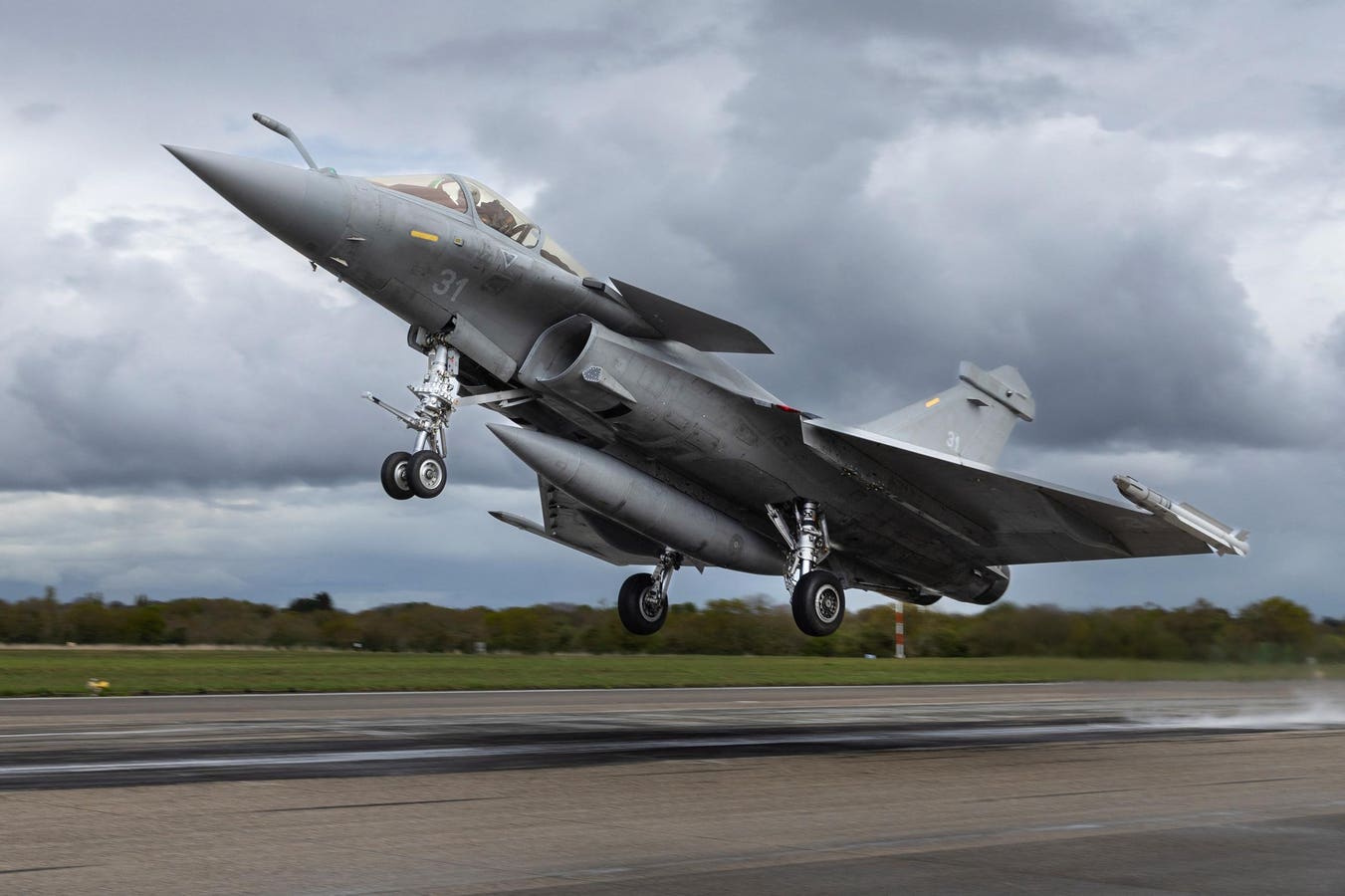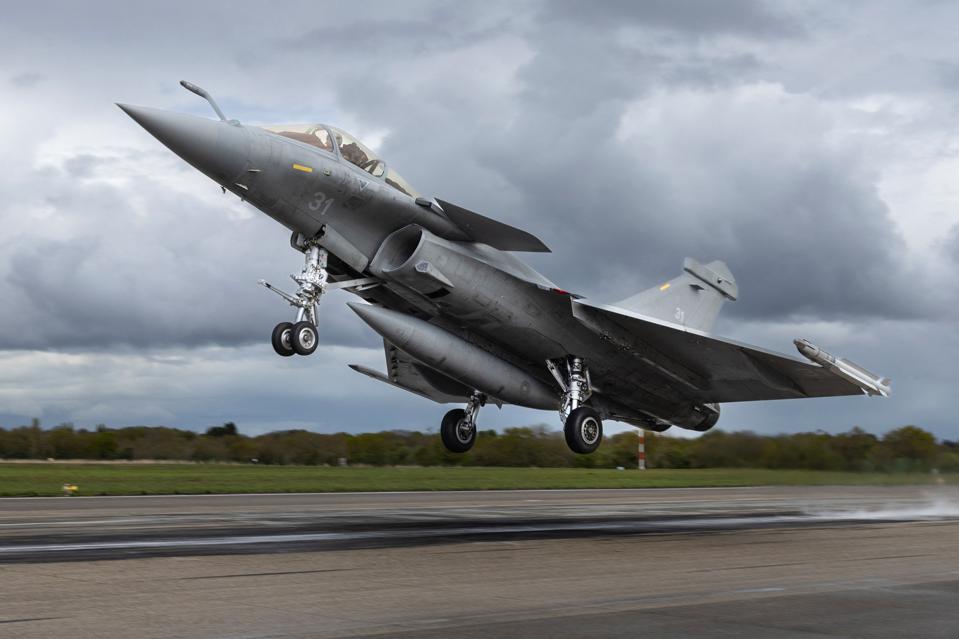Leading-edge French Rafale combat aircraft takes off – NATO chief Mark Rutte says Europe needs more … More jet fighters, more modern tanks, and more missiles to match Russia’s arms build-up. (Photo by Fred TANNEAU / AFP) (Photo by FRED TANNEAU/AFP via Getty Images)
AFP via Getty Images
While threatening to launch nuclear missiles against any Ally helping democratic Ukraine repel its Russian invaders, Kremlin commander-in-chief Vladimir Putin has also warned a direct, armed clash of civilizations with the West could spiral into World War III.
Yet NATO’s Secretary General is now pushing the Allies to swiftly build up their jet fighters, missiles and weaponized drones precisely to avert an all-out war with Russia, which is rearming at a feverish pitch.
Across a series of interviews, scholars on Russia’s race to expand its wartime armaments say Putin aims to trigger fear and inaction on the part of Ukraine’s allies, even as he develops new weapons systems to face off with them.
NATO’s new call to arms, they say, stands a chance of freezing portions of Putin’s masterplan for his tanks and troops to recreate the Russian Soviet Union by reconquering states that have broken free of Moscow’s control.
NATO chief Mark Rutte, while sketching out the escalating dangers posed by Putin and his expansionist quest, told military experts who gathered in London: “Because of Russia, war has returned to Europe.”
Sounding a worldwide alarm—aimed at defense planners across all 32 NATO nations—Rutte said Russia is teaming up with rogue powers stretching from North Korea to Iran as they strengthen their militaries.
“Putin’s war machine is speeding up, not slowing down,” Rutte declared during a talk at the Royal Institute of International Affairs.
“Russia is reconstituting its forces,” the onetime prime minister of the Netherlands said, “and producing more weapons faster than we thought.”
“In terms of ammunition, Russia produces in three months what the whole of NATO produces in a year.”
Moscow’s burgeoning defense factories are set to turn out 200 nuclear-capable Iskander missiles and 1500 tanks this year, and production rates are rising.
“Russia could be ready to use military force against NATO within five years: FIVE YEARS!” Rutte warned.
Quoting Winston Churchill, from a dramatic speech exhorting the British House of Commons to launch a long-delayed weapons build-up to catch up with the Nazis’ rising military power, Rutte said there was no time to lose for Europe to bolster its defenses.
“We need a 400% increase in air and missile defense.”
“We see in Ukraine how Russia delivers terror from above, so we will strengthen the shield that protects our skies.”
NATO’s allies, he said, need many more missile interceptors, more tanks, more rockets, and more expansive navies, even as they modernize their air forces.
As just one step in this direction, he said NATO Allies are set to acquire 700 American F-35 fighter jets.
NATO Allies are set to acquire 700 American F-35 fighter jets in a bid to outpace Russia’s arms … More build-up. (Photo by South Korean Defense Ministry via Getty Images)
South Korean Defense Ministry via Getty Images
NATO partners, he added, will begin building stockpiles of new-generation drones and missile systems, and step up investment in space technology and cyber-warfare expertise.
“On the battlefields of Ukraine,” Rutte boasted, “$400 drones, used the right way, are taking out $2 million Russian tanks.”
“History has taught us that to preserve peace, we must prepare for war,” he said.
Secretary General Rutte suggested that by pumping five percent of each Ally’s gross domestic product into this accelerating arms contest with Russia, the entire North Atlantic Treaty Organization might become so formidable that Moscow would never dare to attack even a single NATO nation, and that the group’s collective defense shield would protect its billion citizens into the future.
NATO’s Allies, its chief said, need many more missile interceptors, more tanks, more rockets, and … More more expansive navies, even as they modernize their air forces. (Photo by Pierre Crom/Getty Images)
Getty Images
Yet leading scholars on Russia’s defense strategies and new weapons programs say it is virtually impossible to pinpoint exactly how the West’s next clash with the Kremlin will start or evolve, or how it could escalate to engulf widening sections of Europe.
Some European military experts, along with Putin himself, have projected that Moscow’s ongoing missile blitzkrieg of Ukraine could burst into a global conflict.
But Spenser Warren, a scholar who is focused on Russia’s drive to strengthen its nuclear arsenal and delivery systems, and on its defense strategies, says: “I don’t think you can predict whether or not this or any war will spiral into World War Three.”
“Most conflicts, even ones that start out seemingly small, have pathways for escalation,” he tells me in an interview.
“WW1 started from a single instance of extremist political violence that was fairly mundane at the time, and engulfed an entire continent plus large parts of Africa, the Middle East, and the Pacific.”
A spectrum of scenarios could spark Russia’s invasion of Ukraine to explode beyond the besieged democracy’s borders, says Warren, a postdoctoral fellow at the University of California Institute on Global Conflict and Cooperation.
“If Russia broadened its attacks to include Western arms depots in places like Poland that are supplying Ukraine, or if a Russian airstrike killed a visiting U.S./European leader (whether intentionally or not), or if Russian pilots accidentally fired on NATO aircraft or a glitch in their navigation software caused them to mistakenly bomb NATO territory,” he says, the war could swiftly “escalate into a regional conflict involving the United States and other NATO members.”
If a limited clash were to erupt between the Kremlin and NATO nations, Warren says, “it would be difficult to predict further escalation.”
“Could such a conflict continue to spiral towards a global war?”
“Yes, that is always an incredibly dangerous risk,” he forecasts.
Warren says he backs NATO chief Rutte’s warnings that the Kremlin could attack a NATO state by the end of the decade.
“There’s of course no guarantee that Russia will be able to rebuild its military effectively in that time period.”
But as of now, Warren says, “They are churning out an incredibly high amount of material.”
“It’s possible that they can maintain that rate long enough to rebuild or even expand their capabilities.”
Moscow is stepping up its production of missiles, tanks and drones, potentially to prepare for an … More armed clash of civilizations with the West (Photo by NATALIA KOLESNIKOVA / AFP) (Photo by NATALIA KOLESNIKOVA/AFP via Getty Images)
AFP via Getty Images
“The threat is serious enough that I would agree with the Secretary General that European countries need to be improving their arms industries and increasing defense spending and production.”
Europe’s failure to match the rapid-fire rise of military rival Moscow—just as France and Britain were overtaken by the meteoric ascent of Hitler and his tanks and Luftwaffe—would make a Russian invasion of one or more EU states more likely.
Putin, surrounded by expanding circles of nationalist zealots, has been laying out plans to despatch invading armies to recapture lands that were once part of the Russian Tsarist empires, or the Soviet Union that followed.
The most likely scenario, Warren says, would likely start with a lightning attack against “former Russian territories”.
“Russian nationalists produce a lot of rhetoric about reconquering lands that the Russian Empire once held for expansionary purposes,” he says.
The Kremlin might opt to attack “a NATO ally (probably one or more of the Baltics) in blitzkrieg fashion,” he says, “and seek to end the conflict before the U.S. and NATO can mount a large response.”
“One of the biggest factors, I think, will be Moscow’s perception of American commitment to the region.”
“If the Kremlin believes the United States will move to defend its allies—and potentially commit enough forces to rollback Russian troops in someplace like the Baltic States or Poland or Romania—then the chance of Russia attacking goes way down.”
“If they believe the United States won’t respond—or think they can create a fait accompli in the Baltics—that risk goes up,” he says.
Elena Grossfeld, an expert on Russia’s defense and intelligence operations at the prestigious King’s College London, says the small, vulnerable Baltic states of Estonia, Latvia and Lithuania, taken over by the Soviet Union in just days at the start of the World War II, are likely prime targets in Putin’s quest to resurrect imperial Russia.
A fluent Russian speaker who closely tracks the Kremlin’s evolving wartime strategies and even the Telegram posts by its most fervent militarists, tells me in an interview: “The Baltics are being thrown around as a target by Russian propagandists, and also by some of Putin’s friends.”
“Realistically due to their size, they could be run over pretty fast.”
“If Russia were to think that the U.S. would not interfere beyond issuing statements and offering thoughts and prayers – it’s a possibility.”
Grossfeld says it is still unclear how strong a defense the U.S. would mount if one of the NATO states, like Lithuania, were captured in an overnight invasion.
Article 5 of the NATO treaty states: “The Parties agree that an armed attack against one or more of them in Europe or North America shall be considered an attack against them all.”
While every NATO member agrees to join a collective defense, she says, each ally determines its own contribution to that defense, “which can include military force but does not have to.”
With its mixed messages on participating in the joint defense of an invaded NATO partner, the U.S. might be opening the way for a series of Russian attacks on the alliance—always testing whether the U.S. will intervene or become increasingly isolationist.
If the White House does pull back, France and Britain, which have already proposed sending peacekeepers into Ukraine after a ceasefire pact is signed, are likely to emerge as the new de facto leaders of NATO in Europe, even as the United States sees its own position on the global stage decline.
As part of its ascent as a supreme guardian of the NATO alliance, France could extend its nuclear umbrella to cover all the other NATO partners across Europe.
France has its own independent arsenal of nuclear weapons, with both submarine and jet bomber delivery systems.
French President Emmanuel Macron, Grossfeld points out, has “already expressed willingness to engage in discussions about extending France’s nuclear deterrent to other European countries.
“France currently has a nuclear weapons stockpile of approximately 290 warheads,” say leading experts at the Federation of American Scientists’ Nuclear Information Project.
“In addition, approximately 80 retired warheads are awaiting dismantlement, giving a total inventory of approximately 370 nuclear warheads.”
In a fascinating overview of the French nuclear arsenal and its changing purpose on the world stage, these experts cite French defense ministry commanders as stating the country’s nuclear doctrine is “strictly defensive,” and that using nuclear weapons “would only be conceivable in extreme circumstances of legitimate self-defense,” involving France’s vital interests.
With expanding signs of a U.S. withdrawal from the European stage, these experts report, France’s use of its nuclear shield is evolving and expanding to cover at least some of its allies.
When President Macron sent leading-edge, nuclear-capable Rafale jets on a joint mission to Sweden in April, they say, the French ambassador told his hosts that France’s “nuclear umbrella also applies to our allies and of course Sweden is among them.’”

